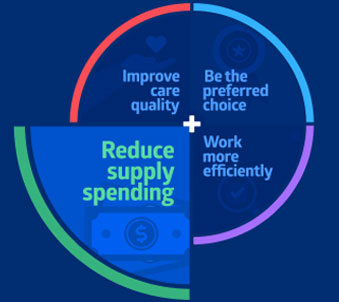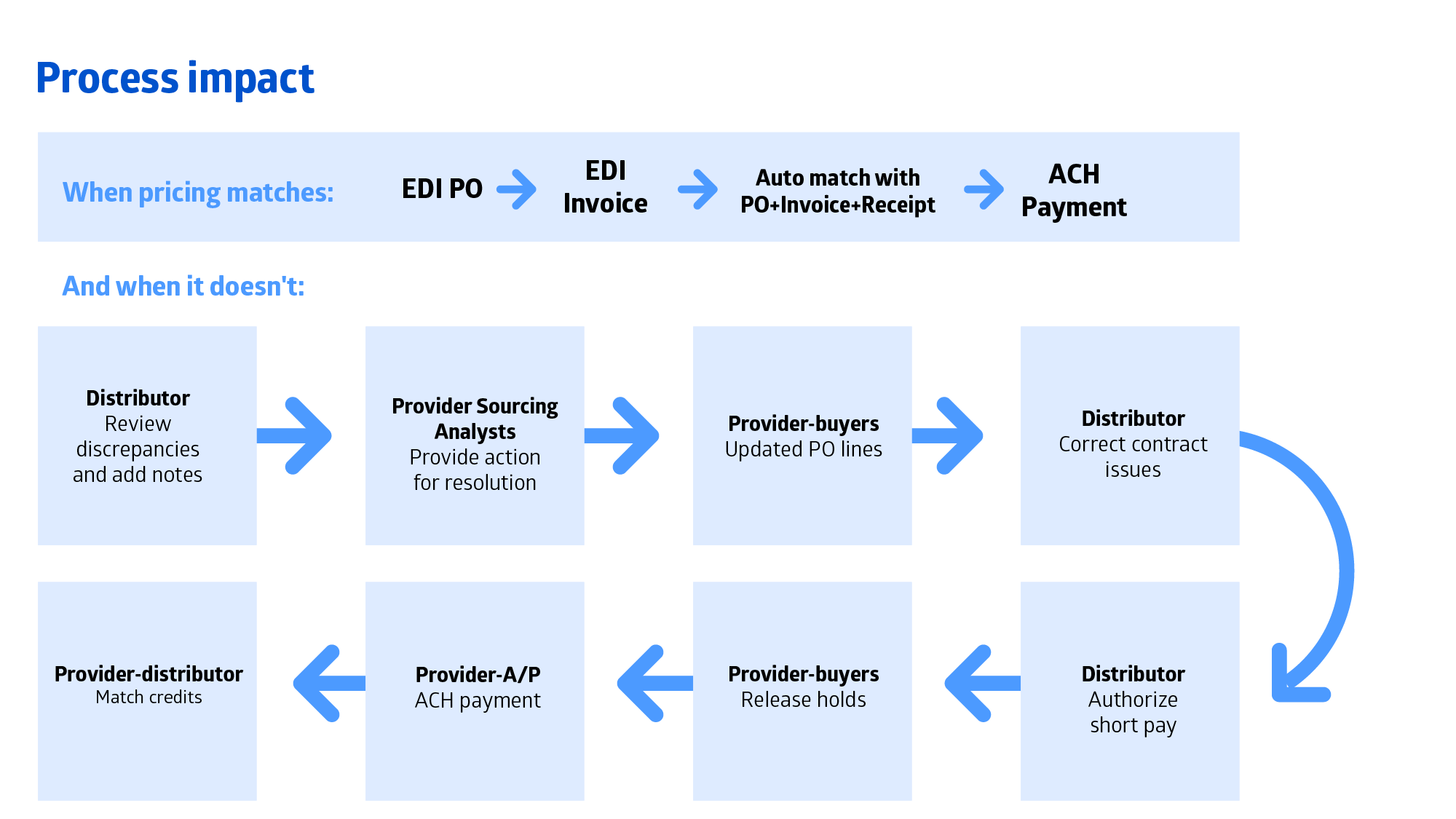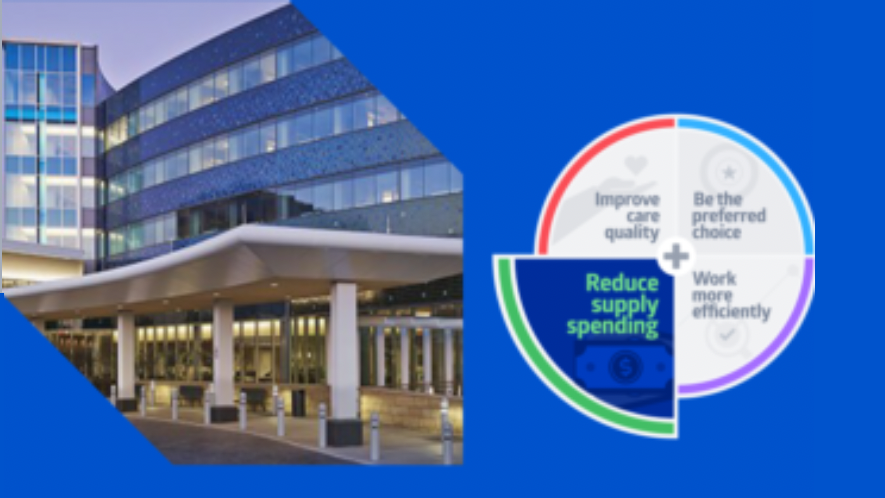
Insight
If there’s anything healthcare supply chain leaders agree upon when it comes to pricing, it’s that the process can be overly complicated. In fact, we know that pricing accuracy in the 70th percentile is about as good as it gets for many health systems, and many don’t recognize the extent to which this impacts their bottom line. In any given month, anywhere from 10,000 to 20,000 products used by a health system may undergo a price change, making it difficult to support or maintain any kind of purchasing improvement strategy. To truly achieve price accuracy, trusted and committed collaboration across the healthcare supply chain continuum is key to success—from manufacturer, to distributor, to group purchasing organization (GPO) and the hospital itself. This is no small task.1
This case study tells the story of how Medline, under a strategic supply chain partnership with UCHealth, dug deep into price data and helped the health system come up with a process for achieving and maintaining price accuracy. The result was greater cost savings and, by way of that, better patient care.

Organization
UCHealth
UCHealth, a nationally recognized healthcare system based in Colorado, operates 12 hospitals and more than 150 clinic locations serving the state’s Front Range region, including metropolitan Denver, northern Colorado and Colorado Springs. In 2021, the 1,997-bed health system reported 141,206 inpatient admissions and observation visits, 4.5 million outpatient visits, 480,767 ER visits and 93,794 surgeries.2
Challenges
Two years into a strategic supply chain partnership to achieve greater cost savings and improve patient care, Medline and UCHealth were finding that price wasn’t always lining up across the health system, Vizient (its GPO) and various manufacturers, making it difficult to load contracts and causing issues downstream.
Actions
- Medline resources pulled and scrubbed data to identify roadblocks to price accuracy.
- Medline and UCHealth designated Vizient, the health system’s GPO, as the single source of truth for all pricing.
- Medline and UCHealth assigned one person—a contract manager—to oversee the pricing process and dog price exceptions and inaccuracies.
- Medline and UCHealth established weekly meetings to crosscheck reports against the master and resolve issues.
Results
- Within the first year, UCHealth witnessed close to 99 percent price accuracy simply by tweaking its processes and has remained in the 90th percentile—accuracy the system says is equating to better payment turnaround and, in general, a heightened awareness and appreciation for the downstream implications when price doesn’t line up.
- New processes have also enabled the system to capitalize on discounts and avoid late fees.
Challenges
UCHealth and Medline had already been working together for nearly a decade when, in 2018, they entered a strategic supply chain partnership to achieve greater cost savings and help improve patient care.3 But by June 2020, getting pricing lined up correctly across the several parties involved—UCHealth, Vizient (the health system’s GPO) and various manufacturers—had become extremely challenging and loading contracts was becoming an issue. “With several parties involved, it was extremely challenging to get pricing right,” says Stephen Newell, senior prime vendor analyst at Medline. “There were lots of hands in the pot.”
It was a situation all too overwhelming for UCHealth supply chain and materials management leaders—faced with the day-to-day priorities of getting the right amount of product to the right department at the right time in multiple locations throughout the state of Colorado—to tackle on its own.
Medline stepped in, dedicating resources to the process of due diligence to get at the root cause, and then helping UCHealth come up with a solution, which, by being proactive, would enable the health system to achieve and maintain price accuracy ongoing.
Actions
Medline started by enlisting additional resources from its own team, pulling and scrubbing data to identify any roadblocks to price accuracy. It was a tenacity and focus that UCHealth says it had not typically experienced from a distributor; understanding and appreciating what Medline was looking to accomplish and how, the health system devoted one of its own resources to the effort.
“We did not have this type of dedication from our previous distributor—shifting from reactive to proactive and having day-to-day due diligence, dedicating a little time every day. It was a complete mind shift to understand downstream implications to payments.”
Jeff Gavi
Director of Strategic Sourcing, UCHealth
Newell explains that the only way to achieve price accuracy is to simplify every step of the process, making it is as quick and efficient as possible, and building it into people’s daily and weekly routines so that it doesn’t become overwhelming. With what it uncovered from the due diligence, Medline went on to recommend a three-pronged strategy for ensuring sustainable outcomes:
- Designate a single source of truth. In this case, the team determined that Vizient, which manages all the contracts as UCHealth’s GPO, should have this role.
- Determine who will be responsible for contract pricing on either side and dedicate this person to the role and process.
- Establish a weekly meeting cadence that includes the health system’s distributor and GPO partners as well as its clinical sourcing and purchasing departments to check the GPO’s baseline reports against the system’s item master. (This was key to addressing some of the deeper problems with pricing errors.)
Single contract manager
In developing a strategy and processes, Medline helped UCHealth create clear lines of communication and assigned a single contract manager to oversee pricing, including all data used to inform decision-making, and drive the new process.
The contract manager oversees the weekly meetings, which provide the opportunity for quick action in resolving mismatches and ensuring that errors don’t multiply. They also help uncover root causes—for example, missing contracts, different tier assignments, locations not receiving contract or tier parity, unit of measure issues, and so on.
Every purchase can compromise price accuracy; by being accountable and staying on it every week, the UCHealth team was able to stay ahead of any issues

Invest in the process
- Prioritize collaboration time and data needs
- Continuously analyze and simplify
- Identify common causes of discrepancies and establish controls to catch and prevent
- Create future pricing reports that show contract/tier alignment post-dated to catch and resolve mismatches
Common discrepancy causes
- Contract not loaded at distributor
- Wrong tier loaded at distributor
- Local contract not loaded at distributor
- Manufacturer changes tier without notice to provider
- Tier or contract parity does not exist
- Item details don’t match between contract and distributor and item master (catalog number, UOM, UOM qty, etc.)
Results
Within the first year, UCHealth witnessed close to 99 percent price accuracy simply by tweaking its processes and has remained in the 90th percentile—accuracy the system says is equating to better payment turnaround and, in general, a heightened awareness and appreciation for the downstream implications when price doesn’t line up.
The changes have also enabled the system to capitalize on discounts, avoid late fees, and get back critical time often lost in the process.
“Where we landed demonstrates that when you redesign a process and collaborate between distributor and provider to improve that process, it really is a win-win on both sides. Especially if you can maintain it.”
Peter McGuire
Former Director of Strategic Sourcing, UCHealth
Price discrepancy issues will always be at the center of purchasing partnerships. However, an integrated, collaborative and automated supply chain will have visibility to price changes and can alert providers, who in turn, can make purchasing decisions that drive out inefficiencies and drive down cost. When everyone is working together and aligned behind a single source of truth, price accuracy becomes a reality.
References:
- https://www.healthdatamanagement.com/articles/how-improved-supply-price-accuracy-can-save-money
- https://uchealth-wp-uploads.s3.amazonaws.com/wp-content/uploads/2022/03/14081023/ABOUT-UCHealth-Fact-Sheet-FY2021-030122.pdf
- https://www.hida.org/uploadedfiles/resources/pricing-accuracy/improving-pricing-accuracy-white-paper-2020.pdf




